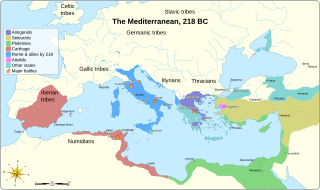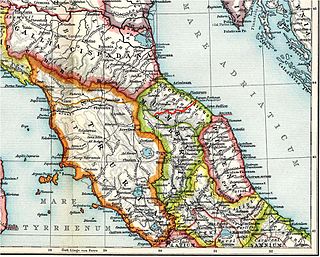Related Research Articles

The Boii were a Celtic tribe of the later Iron Age, attested at various times in Cisalpine Gaul, Pannonia, present-day Bavaria, in and around present-day Bohemia, parts of present-day Slovakia and Poland, and Gallia Narbonensis.

The Second Punic War was the second of three wars fought between Carthage and Rome, the two main powers of the western Mediterranean in the 3rd century BC. For 17 years the two states struggled for supremacy, primarily in Italy and Iberia, but also on the islands of Sicily and Sardinia and, towards the end of the war, in North Africa. After immense materiel and human losses on both sides, the Carthaginians were defeated. Macedonia, Syracuse and several Numidian kingdoms were drawn into the fighting, and Iberian and Gallic forces fought on both sides. There were three main military theatres during the war: Italy, where Hannibal defeated the Roman legions repeatedly, with occasional subsidiary campaigns in Sicily, Sardinia and Greece; Iberia, where Hasdrubal, a younger brother of Hannibal, defended the Carthaginian colonial cities with mixed success before moving into Italy; and Africa, where Rome finally won the war.
The Rubicon is a shallow river in northeastern Italy, just south of Cesena and north of Rimini. It was known as Fiumicino until 1933, when it was identified with the ancient river Rubicon, famously crossed by Julius Caesar in 49 BCE.

The Battle of Lake Trasimene was fought when a Carthaginian force under Hannibal ambushed a Roman army commanded by Gaius Flaminius on 21 June 217 BC, during the Second Punic War. The battle took place on the north shore of Lake Trasimene, to the south of Cortona, and resulted in a heavy defeat for the Romans.

Cisalpine Gaul was the name given, especially during the 4th and 3rd centuries BC, to a region of land inhabited by Celts (Gauls), corresponding to what is now most of northern Italy.

Gallia Narbonensis was a Roman province located in what is now Occitania and Provence, in Southern France. It was also known as Provincia Nostra, because it was the first Roman province north of the Alps, and as Gallia Transalpina, distinguishing it from Cisalpine Gaul in Northern Italy. It became a Roman province in the late 2nd century BC. Gallia Narbonensis was bordered by the Pyrenees Mountains on the west, the Cévennes to the north, the Alps on the east, and the Gulf of Lion on the south; the province included the majority of the Rhone catchment. The western region of Gallia Narbonensis was known as Septimania. The province was a valuable part of the Roman Empire, owing to the Greek colony of Massalia, its location between the Spanish provinces and Rome, and its financial output.

Roman Gaul refers to Gaul under provincial rule in the Roman Empire from the 1st century BC to the 5th century AD.

The Aulerci Cenomani were a Gallic tribe dwelling in the modern Sarthe department during the Iron Age and the Roman period. The Cenomani were the most powerful of the Aulerci tribes.

Brennus was a chieftain of the Senones. He defeated the Romans at the Battle of the Allia. Later that year, he led an army of Cisalpine Gauls in their attack on Rome and captured most of the city, holding it for several months. Brennus' sack of Rome was the only time in 800 years the city was occupied by a non-Roman army before the fall of the city to the Visigoths in 410 AD.

The Battle of Insubria in 203 BC was the culmination of a major war, carried out by the Carthaginian commander Mago, brother of Hannibal Barca, at the end of the Second Punic war between Rome and Carthage in what is now northwestern Italy. Mago had landed at Genoa, Liguria, two years before, in an effort to keep the Romans busy to the North and thus hamper indirectly their plans to invade Carthage's hinterland in Africa. He was quite successful in reigniting the unrest among various peoples against the Roman dominance. Rome was forced to concentrate large forces against him which finally resulted in a battle fought in the land of the Insubres (Lombardy). Mago suffered defeat and had to retreat. The strategy to divert the enemy's forces failed as the Roman general Publius Cornelius Scipio laid waste to Africa and wiped out the Carthaginian armies that were sent to destroy the invader. To counter Scipio, the Carthaginian government recalled Mago from Italy. However, the remnants of the Carthaginian forces in Cisalpine Gaul continued to harass the Romans for several years after the end of the war.
The phrase "crossing the Rubicon" is an idiom that means "passing a point of no return". Its meaning comes from allusion to the crossing of the river Rubicon by Julius Caesar in early January 49 BC. The exact date is unknown. Scholars usually place it on the night of 10 and 11 January because of the speeds at which messengers could travel at that time. It is often asserted that Caesar's crossing of the river precipitated Caesar's civil war; however, Caesar's forces had already crossed into Italy and occupied Ariminum the previous day.
Cisalpine is an adjective referring to the Italian side of the Alps. If may refer to:
The Celtic Cisalpine Gaulish inscriptions are frequently combined with the Lepontic inscriptions under the term Celtic language remains in northern Italy. While it is possible that the Lepontii were autochthonous to Northern Italy since the end of the 2nd millennium BC, it is known from ancient sources that the Gauls invaded the regions north of the river Po in several waves since the 5th century BC. They apparently took over the art of writing from the Lepontii, including some of the orthographic peculiarities. There are 20 Cisalpine Gaulish inscriptions, five of them longer than just one or two words. The inscriptions stem largely from the area south of the Lepontians.

The Cenomani, was an ancient tribe of the Cisalpine Gauls, who occupied the tract north of the Padus, between the Insubres on the west and the Veneti on the east. Their territory appears to have extended from the river Addua to the Athesis.
The Helvii were a relatively small Celtic polity west of the Rhône river on the northern border of Gallia Narbonensis. Their territory was roughly equivalent to the Vivarais, in the modern French department of Ardèche. Alba Helviorum was their capital, possibly the Alba Augusta mentioned by Ptolemy, and usually identified with modern-day Alba-la-Romaine. In the 5th century the capital seems to have been moved to Viviers.

The Roman expansion in Italy covers a series of conflicts in which Rome grew from being a small Italian city-state to be the ruler of the Italian region. Roman tradition attributes to the Roman kings the first war against the Sabines and the first conquests around the Alban Hills and down to the coast of Latium. The birth of the Roman Republic after the overthrow of the Etruscan monarch of Rome in 509 BC began a series of major wars between the Romans and the Etruscans. In 390 BC, Gauls from the north of Italy sacked Rome. In the second half of the 4th century BC Rome clashed repeatedly with the Samnites, a powerful tribal coalition of the Apennine region.

Over the course of nearly four centuries, the Roman Republic fought a series of wars against various Celtic tribes, whom they collectively described as Galli, or Gauls. Among the principal Gallic peoples described as antagonists by Greek and Roman writers were the Senones, Insubres, Boii, and Gaesatae.

The Battle of Silva Litana was an ambush that took place in a forest 75 miles northwest of the Roman city of Ariminum during the Second Punic War in 216 BC. The Gallic Boii surprised and destroyed a Roman army of 25,000 men under the consul-elect Lucius Postumius Albinus and destroyed the Roman army, with only ten men surviving the ambush, a few prisoners were taken by the Gauls and Postumius was killed, his corpse was decapitated and his skull was covered with gold and used as a ceremonial cup by the Boii. News of this military disaster, reaching Rome probably after the election of consuls for 215 BC in Spring 215 BC or after the defeat at Cannae in the fall of 216 BC, triggered a renewed panic in Rome and forced the Romans to postpone military operations against the Gauls until the conclusion of the Second Punic War. Rome decided to focus on defeating Hannibal and sent only two legions to guard against any possible Gallic attack, however, the Boii and Insubres did not attack the Romans to exploit their victory. Cisalpine Gaul remained in relative peace until 207 BC, when Hasdrubal Barca arrived in Cisapline Gaul with his army from Spain.
References
- ↑ Livy. Ab urbe condita Libri [History of Rome]. Vol. XXXIX. 2.